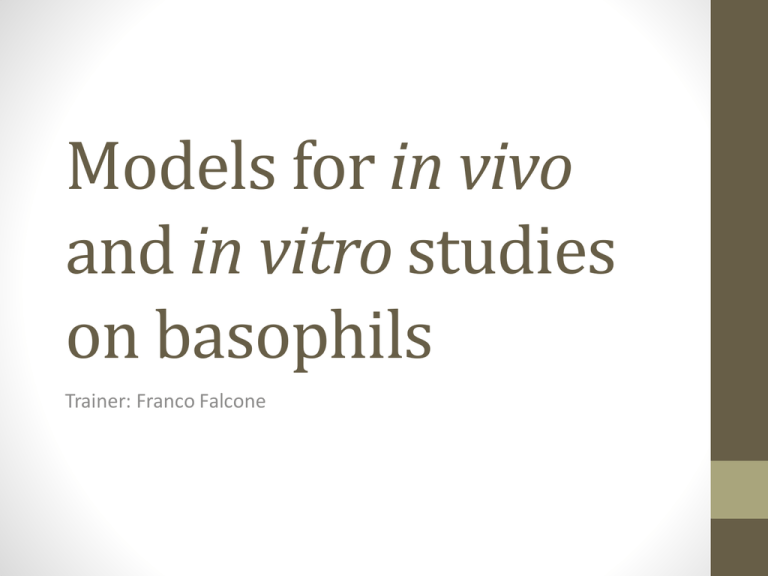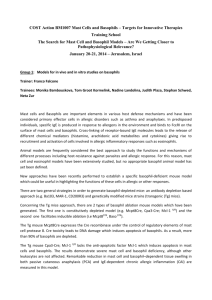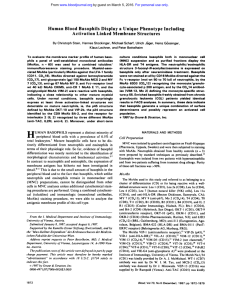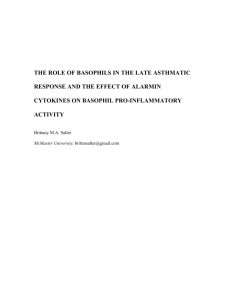Group_1_Presentation - Mast Cell
advertisement

Models for in vivo and in vitro studies on basophils Trainer: Franco Falcone Introduction • Basophils were discovered more than century ago (1879) • Only recently they have been identify to play a role in allergy (1972) • Compared to human, mice have less basophils which were initially more difficult to identify. First discovery of mouse basophils by EM in 1981 How to deplete basophils in mice • No naturaly occuring basophil defficiency in mice • Antibody induces defficiency Mar-1 Anti-FcseRI mAb Ba103 anti-CD200R3 mAb • Not selective only for basophils! • Posible activation and/or depletion of mast cells • Depletion of DC subpopulations (antigen presentation properties?) • Not optimal depletion efficiency (80 – 90% for Ba103) • Problematic timing in long term experiments Other models are needed! Transgenic models BasoDTR DTR transgene (expression under CD203c promotor Diphteria toxin injection Cells express DTR allowing inducible deletion Depletion of basophils 84% NA Aims: • To reveal contribution of basophils and eosinophils in IgE-CAI in vivo. • To generate a new mouse models lacking basophils and eosinophils. • BasoDTR mice - hDTR espression driven by CD203c promotor (basophil marker) • EoDTR mice - hDTR espression driven by EPO promotor (eosinophil peroxidase, granule cationic protein) Basophil-speciphic ablation after DT administration in BasoDTR mice • Decrease in basophils in peripheral blood (84%) and spleen • No decrease in basophil population in bone-marrow! • qPCR and WB analysis failed to detect hDTR in bone-marrow • No effect on peritoneal mast cells IgE-mediated chronic allergic (CAI) reaction in BasoDTR mice • • TNP-spec. IgE i.v. 24 hrs TNP-OVA i.d. DT treatment in BasoDTR mice almost completely abolished developement of IgE-CAI IgE-CAI in EoDTR • • DT added -2days before Ag DT treatment abolished the IgE-CAI in EoDTR mice • Eosinophils are involved in ear swelling exacerbation rather than induction of inflammation Pros and cons + efficient systemic depletion + first inducible depletion of eosinophils - No convincing evidence about CD203c expression in mice basophils and not in other cell types - What happens to other cells is not discused (Table 1) - Only one time poind measured - Significance for chronic models (IgE-CAI?) - High concentrations of DT affects also other cells Aims: • Generate mast cell and basophil deficient mouse model Background: – Based on finding that Myeloid cell leukemia sequence-1 (Mcl-1) is shown to be an intracellular anti-apoptotic factor – Increased apoptosis of cells that do express Cpa3 • Cpa3 is highly expressed in mast cells • Efficient mast cell depletion in all tested tissues, except for spleen • Cpa3 is expressed in subpopulation of basophils • Efficient basophil depletion in tested tissues (56-78%) • Cpa3 is expressed in neutrophils, eosinophils, T cells,b cells • Other cells type numbers not affected, except for RBC • PCA: Passive cutaneous anaphylaxis, Mast cell-dependent reaction PCA (mast cells) • CAI: Chronic allergic inflammation, basophil-dependent reaction (contribution of mast cells ignored here?) CAI (basophils) Pros and cons + efficient depletion of mast cells + constitutive depletion (e.g. chronic models) - Quite inefficient depletion of basophils; 22-42% of basophils are still present; what happens in a more subtle model in which basophils are involved? - Not a good model for investigating basophils; mast cells are depleted - No depletion of mast cells in spleen Aims: • To asses the role of basophils in acquired tick resistance Background: – Basophil depleting antibodies used (Ba103, anti-CD200R3) – Selective inducible ablation of basophils – Mctp8DTR mice – hDTR expressed under the control of basophil speciphic promoter of Mcpt8 Acquired resistance to ticks • Resistance measured as the time of feeding • Resistance is mast celldependent • FceRI and antibody independent Recruitment of basophils to tickfeeding sites during the second infestation DT-mediated basophil ablation in Mctp8DTR mice • A: DT abolished acquired tick resistance in Mctp8DTR mice • B: Basophils and mast cell numbers in skin 4 days after the initiation of second infestation Pros and cons + efficient basophil depletion + no other cell types appear to be affected - High concentrations of DT affects also other cells - Significance for chronic models (IgE-CAI?) Conclusions • Selective ablation of basophils showed to be powerful tool in studying their role in physiological conditions • Limitations in basophil specific markers • Limitations in tools for inducing depletion (DT) • Constitutive depletion might affect also mast cells numbers (Cpa3-Cre) • Mcpt8-Cre might be a good alternative Suggestions • Search for more specific basophil markers? • Mctp8 is currently the best option • GFP expression only in basophils is important control (mctp8 promotor control, different cells from several tissues were checked) • Best model (Mctp8) is good only for mice, not for human • Toxic effects of DT, dose-dependent • Fast recovery of basophils – should be DT administration repeated? • Hello kitty – only part of the promotor, mediates moderate Cre expression • Cpa3 KO has different phenotype than Cpa3-Cre • Side effects of Cre expression in other tissues? • Overexpression of basophil population is missing in the literature



![Historical_politcal_background_(intro)[1]](http://s2.studylib.net/store/data/005222460_1-479b8dcb7799e13bea2e28f4fa4bf82a-300x300.png)






